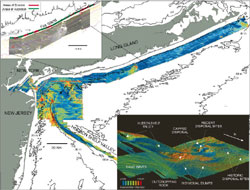
[Click on thumbnail to open larger
image in new window]
|
Figure 3. The USGS has mapped the sea floor in the New York Bight apex and along the southern shore of Long Island by using sidescan sonar, and the Hudson Shelf valley and adjacent shelf by using multibeam. This combined backscatter image (red is high backscatter and blue is low backscatter) shows a complex pattern of sediment properties that is a result of the underlying geology, modern processes, and anthropogenic activity. The backscatter intensity is related to sediment texture, as well as other properties. In general, high backscatter indicates coarse-grained sediment or outcropping rock, and low backscatter indicates fine sands, silt, or clays. The Hudson Shelf valley is floored with fine-grained sediments. The box outlines the location of the multibeam image shown at right; the black arrow indicates the look direction -- to the southwest. From Schwab and others (1997); Butman and others (1998).
|
|
Top left: Along the southern shore of Long Island, Cretaceous age (>65 million years old) rocks outcrop approximately 6 kilometers off central Fire Island (bright high-backscatter region) and exert a primary control on observed patterns of coastal change. This area acted as a headland during times of lower sea level about 10,000 years ago. Erosion of this headland during subsequent sea-level rise furnished sediments to the inner shelf downdrift to the west. These sediments, in turn, were reworked by oceanographic processes into a series of sand ridges. Note the halo of coarser sediment to the west of the outcropping rock. A westward and onshore sediment flux from these ridges may supply sediment to the beaches of western Fire Island and may influence the pattern of erosion of the barrier-island system. From W.C. Schwab and others, written commun. (1998).
|
Lower right: Sun-illuminated perspective view (looking to the southwest) of the topography and sediment characteristics of the shelf at the head of the Hudson Shelf valley (area in box, fig. 3). The image was constructed by draping color-coded backscatter intensity over the bathymetry, as measured by a multibeam system. Water depth at the northern portion of the region is approximately 30 meters; water depth in the Hudson Shelf valley at the left of the image is about 50 meters. Features observed include relatively smooth mounds composed of material dumped since the 1800's; mounds (as high as 10 meters) of dredged material from more recent disposal; a smooth, roughly circular region that resulted from disposal of contaminated sediments and is capped with coarse sand; outcrops of southwestward-dipping Cretaceous age coastal plain strata at the head of the Hudson Shelf valley; low-relief (amplitude <1 meter) sand waves suggesting sediment transport to the southwest; and individual dumps of material, some arranged in lines, in some cases probably large rocks from construction activity in New York (referred to as "derrick stones"). From Butman and others (1998).
|



